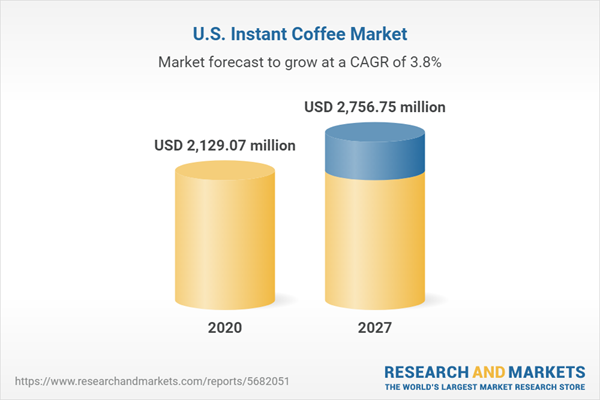The market for instant coffee in the United States is projected to grow in the forecast period as coffee is an extremely popular drink preferred by people of all ages. As per the National Coffee Association Survey statistics, in 2019, around 64% of Americans 18 years or older consumed coffee every day. Drinking at home is mostly preferred accounting for around 79% of the total coffee consumption. On the other hand, around 36% of Americans in the country consume coffee in coffee shops.
As per the survey data, around 60% of Americans were reported to drink coffee regularly from a network of branded coffee houses. On the basis of gender-based consumption, it was reported that men consume around 1.7 cups of coffee every day on average. In comparison, women were estimated to consume around 1.5 cups of coffee every day. The data indicated that nearly the same amount of coffee was consumed among males and females in the country.
As per the survey data, during the fiscal year 2018/2019, the overall coffee consumption in the United States increased to around 26.5 million 60-kg bags the previous years. It was found that there is a substantial amount of coffee consumption among different work spheres. Finance professionals were accounted to spend around USD709 per year on coffee. Individuals in business were accounted to spend around USD592 on coffee products, whereas Americans in the medical and healthcare sectors spent around USD440 in a year. Additionally, workers in transportation and warehousing were accounted to spend around USD150 on coffee in a year.
As per the NCA survey data, coffee consumption among millennials is quite high. Around 70% of the coffee drunk by these consumers are gourmet beverages, while around 30% are non-gourmet beverages. It was found that around 32% of millennials are known to consume espresso-based drinks per day, and it was estimated to be higher in comparison to any other demographic in the country. Around 15% of the millennials were found to consume their coffee in cafés, coffee shops, or in a donut shop. This was recorded to be the highest consumption in this segment.
In 2020, amid the novel coronavirus outbreak, the closure of many cafes and restaurants across the United States to prevent virus transmission was projected to have a negative impact on the market growth. However, coffee services are active in the drive-thru, and cafes serving in and around hospitals and healthcare are still functioning.
It has been assessed that the overall market in the United States for instant coffee is projected to experience slow growth during the forecast period. This is mainly due to the poor reputation of instant coffee in the region. The big companies in the United States make loads of commercial instant coffee and purchase poor-quality beans for the manufacturing of instant coffee. Hence, this has led to a dislike for instant coffee among consumers, and they are shifting their focus on other types of coffee varieties like roast and ground coffee or specialty coffee. However, with the rise in the manufacturing of high-quality instant coffee, the market is further projected to experience steady growth in the forecast period.
Key Developments in the Market:
- In April 2022, NuZee, Inc., a leading single-serve coffee co-packing company, announced the launch of its new co-packing segment, instant coffee. This development was an outcome of a non-exclusive co-packing and manufacturing agreement with Wild Society Coffee. This collaboration made the new instant coffee packaging available through e-commerce.
- In February 2020, as part of the global coffee alliance, Nestle S.A. collaborated with Starbucks Corp. to develop top-quality instant coffee offerings. Starbucks' new premium instant coffee line will be available in many markets worldwide, including the United States.
COVID-19 Insights
COVID-19 had a negative impact on the United States instant coffee market. The surge in infected cases across the country led to the enforcement of a lockdown across the country. Subsequently, multiple institutions, corporations, food cafes, and many other public places were closed, causing the sales to decline in these segments. Nevertheless, owing to the deployment of work-from-home and online classes, increased sales in the domestic segment. The rapid adoption of the e-commerce segment further added impetus to the growth.Segmentation:
By Type
- Freeze-Dried Instant Coffee
- Spray-Dried Instant Coffee
By Distribution Channel
- Offline
- Retail
- Supermarket/Hypermarket
- Convenience Stores
- Food Services
- Online
By Cities
- New York
- Los Angeles
- Chicago
Table of Contents
Companies Mentioned
- Nestle
- Starbucks Coffee Company
- Tata Coffee
- Kraft Heinz Company
- Tastlé
- First Ascent Coffee Roasters
- OZO Coffee Company
- Intelligentsia Coffee
Table Information
| Report Attribute | Details |
|---|---|
| No. of Pages | 80 |
| Published | September 2022 |
| Forecast Period | 2020 - 2027 |
| Estimated Market Value ( USD | $ 2129.07 million |
| Forecasted Market Value ( USD | $ 2756.75 million |
| Compound Annual Growth Rate | 3.7% |
| Regions Covered | United States |
| No. of Companies Mentioned | 8 |









